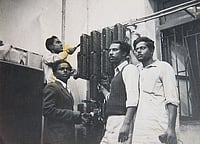Dr Nidal Abed works in a hospital in Gaza. He treats patients wherever he can, — on the floor, in the corridors, in rooms crammed with 10 patients instead of two, and however he can – using clothes for bandages, vinegar for antiseptic, sewing needles for surgical ones. The only thing worse than the screams of a patient undergoing surgery without enough anaesthesia are the terror-stricken faces of those awaiting their turn, the 51-year-old orthopedic surgeon says.
Hospitals In Gaza Were Once A Safe Haven
Israeli attacks targeted healthcare infrastructure in Gaza, including hospitals, ambulances and medical personnel who were often in the proximity of hospitals, killing thousands of people

Hospitals in Gaza have become a combat zone during Israel’s war on the besieged territory since October 7. For long, Israel has alleged that militant group Hamas maintains a sprawling command post inside and under Gaza’s largest hospital Al-Shifa – often without evidence. Hamas too has denied these allegations. International human rights organisations have criticised Israel’s attacks on Gaza hospitals and termed it as “Israel's reckless endangerment of civilians.”?
A four-day humanitarian pause in Israel’s war on Gaza has now been extended for two more days, bringing some relief to Palestinians. However, videos from the region show dilapidated hospitals, with many wounded patients awaiting treatment and evacuation to ‘safer’ zones. Among them, also lay fears of the war erupting again.
According to international humanitarian law, hospitals and medical personnel are protected during conflicts and direct attacks against civilians and civilian objects are prohibited. Even in exceptional cases where hospitals lose their protection under international law, attacks must adhere to strict rules of precaution, necessity, and proportionality “to avoid or minimise civilian harm”.
However, Israeli attacks targeted healthcare infrastructure in Gaza, including hospitals, ambulances and medical personnel who were often in the proximity of hospitals, killing thousands of people. As of 20 November, more than 60 ambulances have been attacked, with 55 damaged or out of service, based on data from the Palestinian health ministry. The director of the biggest hospital in the besieged Palestinian territory has been arrested along with five other health workers by Israel.
Gaza's hospitals, now war zones
When their homes became warzones, Palestinians fled to medical centres, in the hope that these grounds were safer than their own homes. But on October 18, an Israeli airstrike hit the Al-Ahli Baptist hospital, lying in the centre of the besieged Gaza Strip, killing at least 500 people. The hospital was crowded with victims of 10 days of Israeli airstrikes and with families and others seeking refuge.?
“People left their homes thinking they were more dangerous and they moved to our schools and hospitals to be safe. And in one minute, all of them have been killed at a hospital,” Dr Ziad Shehadah told Al Jazeera.
Kamal Najar, a 35-year-old who sheltered at Gaza’s biggest hospital Al Shifa with his toddler son and infant daughter, said he believed that the hospital would be “off-limits, even for Israel.” However, on November 15, Israeli forces raided Shifa, where thousands of Palestinians were sheltering, following days of heavy attacks in the area surrounding the complex in Gaza City, killing at least 32 patients, including three babies.
Shifa has over 500 beds and services like MRI scans, dialysis and an intensive care unit. It used to conduct roughly half of all the medical operations that took place in Gaza, according to the Health Ministry. But now, Shifa can no longer provide most treatment after it ran out of water, medical supplies and fuel for emergency generators because of a territory-wide blackout.
Although humanitarian groups and rescue officials tried to transport the wounded to other hospitals – like the Indonesian Hospital – Israeli forces left no stone unturned to attack these spaces as well.?
The Indonesian hospital is located in the city of Beit Lahiya in North Gaza. It was built with the funds from donations by Indonesian citizens and groups including the Indonesian Red Cross Society and the Muhammadiyah Society, one of Indonesia’s largest Muslim organisations. At least 12 people, including patients and their families were killed when a shell struck the second floor of the hospital.
Hospitals in the Gaza strip were already nearing collapse under an Israeli blockade that cut power and deliveries of food and other necessities to the territory. They lacked clean water. They were running out of basic items for easing pain and preventing infections. Fuel for their generators was dwindling.?
To add to their despair, Israeli attacks on these vulnerable medical centres left no safe space for wounded people to be treated in and for Palestinian families to seek shelter in.?
What were once safe havens for many, have now turned into death zones.?
- Previous Story
 Canadian Border Cop Named In India's Terror List; Ottawa Minister's 'On Notice' Warning To Diplomats | Latest
Canadian Border Cop Named In India's Terror List; Ottawa Minister's 'On Notice' Warning To Diplomats | Latest - Next Story




















